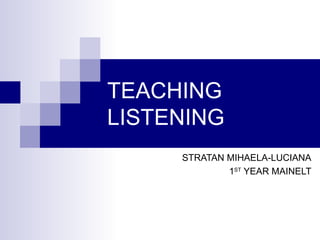
122623701 teaching-listening
- 2. Microskills of listening comprehension Retain chunks of language of different lengths in short term memory; Recognize reduced forms of words; Discriminate among the distinctive sounds of English; Develop and use a battery of listening strategies such as detecting key words, guessing the meaning of words from context, appeal for help, and signaling comprehension or lack thereof.
- 3. Types of classroom listening performance Reactive Intensive Responsive Selective Extensive Interactive
- 4. REACTIVE LISTENING The listener has the role of a ”tape recorder” The listener is not generating meaning The teacher is the model The only role that reactive listening can play in an interactive classroom is in brief coral or individual drills that focus on pronunciation
- 5. INTENSIVE LISTENING It focuses on components of discourse such as: phonemes, words, discourse markers. It uses bottom-up skills like: Students listen for cues in certain coral or individual drills The teacher repeats a word or sentence a several times to ”imprint” it in the students’ mind The teacher asks students to a sentence or a longer stretch of discourse and to notice a specified element, such as intonation, stress, a contraction, a grammatical structure etc.
- 6. RESPONSIVE LISTENING Short stretches of teacher language designed to elicit immediate responses The students’ task is to process the teacher talk immediately and to fashion an appropriate reply Examples: Asking questions like : ”How are you today?” Giving commands : ”Open the window!” Seeking clarification : ”What was the word you said?” Checking comprehension
- 7. SELECTIVE LISTENING Requires field independence Listening for specific information: people’s name dates certain fact or events main ideas or conclusion location, situation, context.
- 8. EXTENSIVE LISTENING Global understanding of spoken language May require the student to invoke other interactive skills (e.g. note-taking, and/or discussion) or full comprehension
- 9. INTERACTIVE LISTENING Students need to use speaking skills too in: Discussions Debates Role-plays
- 10. Principles for Designing Listening Techniques Making sure that input is converted into intake techniques for developing listening comprehension Intrinsically motivating techniques appeal to listeners’ personal interests and goals use your students’ cultural background to facilitate the process of listening Authentic language and contexts the students can see the relevance of classroom activity to their long term communicative goals
- 11. Principles for Designing Listening Techniques Listeners’ responses Teachers should design techniques in such a way that students’ responses indicate whether or not their comprehension has been correct Listening strategies as: Looking for new words Guessing at meanings Associating information with one’s existing cognitive structure (activating background information) Seeking clarification Bottom-up and top-down techniques
- 13. Top-down techniques Activation of schemata Deriving meaning Global understanding The interpretation of a text
- 14. The basic structure of a good listening lesson: Before Listening Introduce the topic and find out what they already know about it (some discussion questions related to the topic). Then provide any necessary background information and new vocabulary they will need for the listening activity. During Listening Be specific about what students need to listen for. They can listen for selective details or general content, or for an emotional tone such as happy, surprised, or angry. If they are not marking answers or otherwise responding while listening, tell them ahead of time what will be required afterward. After Listening Finish with an activity to extend the topic and help students remember new vocabulary. This could be a discussion group, craft project, writing task, game, etc.
- 15. TIPS FOR TEACHERS Use short recordings (2-3 minutes). Let students check their answers in pairs before you ask for feedback from the whole class. Make it an easy task. Allow the students to control the recorder sometimes. Give students the task in advance
- 16. THANK YOU ALL FOR YOUR ATTENTION !!!
